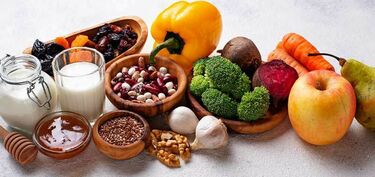The bacteria in your gut can be a tower of strength for your health and wellbeing – provided you give it what it needs.
Our large intestine is a very busy place. In fact, it's home to trillions – yes, trillions – of microorganisms.
The microorganisms that live in our large intestine are mainly bacteria and are an important part of our gut microbiota, says Accredited Practising Dietitian Kim Menzies.
"Looking after your gut microbiota is important for your digestive health," says Ms Menzies. "It's also important for your broader health."
Poor gut health is linked to many health problems including obesity, diabetes, heart disease, anxiety, skin conditions and inflammation associated with autoimmune conditions.
Good gut health, says Ms Menzies, is about "eating a wide variety of unprocessed foods."
The more species of bacteria you have in your gut, the healthier your gut is. In fact, a healthy gut microbiota may contain more than 1000 species of bacteria, while an unhealthy one may have as few as 15 species.
Gut bacteria digests food that has not been broken down by the body. The welcome by-products of the gut bacteria breaking down certain fibres are short-chain fatty acids.
"Short-chain fatty acids are a really good food source for the cells of the gut and they are very protective for our health," says Ms Menzies.
Apart from digesting fibres, gut bacteria also work hard to keep the intestinal lining intact, prevent infection and stop harmful bacteria from making a home in the gut.

Eating a wide variety of unprocessed foods of many different colours is a good way to increase the fibre in your diet. To do this, Ms Menzies encourages you to "think about your eating across an entire week, not just one day."
"Life is busy, and it can be difficult to maintain consistency each day," she says. "Looking at the week in its entirety means you can plan more thoroughly and make adjustments where possible.
"Always look for opportunities to swap out a more processed option for a higher-fibre option."
High-fibre foods include:
A diet rich in all types of fibre is very good for your gut microbiota. Insoluble fibre, soluble fibre, resistant starch and pre-biotic fibres are all important for creating diverse gut bacteria.
Some great sources of the different fibres you could consider including in your weekly eating plan are:
Ms Menzies says it's ideal to eat something that has live bacteria in it every day. "Yoghurt is a great option, particularly pot-set yoghurts, as the bacteria will continue to grow while in the tub," she says.
"Other options are kefir (live milk-based culture) and sauerkraut. But ensure they are from a refrigerated source."
For more information on eating for good health, please visit our Eating for good health page.
This article was made possible with the support of our sponsor, Dairy Australia.
All reasonable steps have been taken to ensure the information created by Jean Hailes Foundation, and published on this website is accurate as at the time of its creation.
© 2025 Jean Hailes Foundation. All rights reserved. This publication may not be reproduced in whole or in part by any means without written permission of the copyright owner. Contact: licensing@jeanhailes.org.au